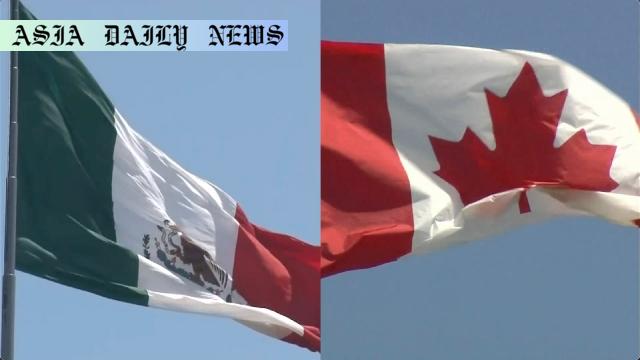tariffs: The US prepares to institute notable tariffs on imports from Canada, Mexico, and China to tackle pressing cross-border issues.
- The US will enforce 25% tariffs on Canada, Mexico, and China starting Tuesday.
- The measure aims to curb drug smuggling and address trade deficits.
- Concerns about inflation and expensive imports follow announcement.

Introduction: US Tariff Plans Take Center Stage
The United States has unveiled plans to impose significant tariffs on goods imported from Canada, Mexico, and China. Announced by Commerce Secretary Howard Lutnick, these tariffs are set to take effect on Tuesday, marking a critical step in the US administration’s efforts to address illicit activities such as cross-border drug smuggling and economic imbalances.The tariffs on Canadian and Mexican imports are aimed at combating the illegal trafficking of drugs into the US. Initially proposed in February, their implementation was delayed by one month to allow both countries to demonstrate progress in mitigating the issue. While Lutnick acknowledged that Canada and Mexico had made reasonable strides, he emphasized that the tariffs would still proceed as planned, symbolizing both a punitive and preventative approach to curb these cross-border challenges.
Targeting China: The Escalation of Economic Tensions
China is also in the crosshairs of the US administration’s tariff agenda. Since early February, the United States has levied a 10% tariff on Chinese goods, and the rate is scheduled to double to 20% on Tuesday. This decision underscores a steadfast intention to hold China accountable for trade imbalances and other economic practices deemed unfair by Washington.While these tariffs aim to rectify specific issues, they signal a deepening rift in US-China trade relations. Economists have expressed concern about the potential consequences of these measures on global trade and inflation, with predictions of higher prices for American consumers. Despite these warnings, President Trump has dismissed any significant impact on inflation, asserting that tariffs were managed effectively during his first term in office.
Economic and Political Ramifications
The adoption of these tariffs has sparked widespread debate. On one hand, proponents argue that these measures are essential to protect US industries, address illicit drug trafficking, and correct trade imbalances. They believe that the tariffs serve as a tool to compel other nations to take responsibility and collaborate on shared challenges.On the other hand, critics caution that the ripple effects of these tariffs could burden consumers and businesses. For instance, the cost of imported goods is likely to rise, exacerbating financial pressures on households and potentially increasing inflation. Furthermore, such measures could strain trade relationships, particularly with neighboring allies Canada and Mexico, whose economic ties with the US are crucial to regional stability.
The Path Forward: Seeking Solutions and Compromising
As the US prepares to enforce these tariffs, it is imperative to strike a balance between safeguarding national interests and avoiding unintended economic repercussions. Engaging in constructive dialogue with the affected nations may help mitigate tensions and foster collaboration on shared challenges such as drug trafficking and trade disputes. Global trade dynamics are inherently interconnected, and unilateral measures could have far-reaching consequences if not implemented alongside multilateral strategies.Ultimately, the upcoming tariff policies represent a pivotal test for the US administration. How it navigates these complex economic and diplomatic waters could shape its legacy and set the tone for future trade relations. Vigilant monitoring of the impact of these tariffs is critical to ensure that short-term goals do not come at the expense of long-term stability and growth.



Commentary
The Implications of US Tariff Policies
The United States’ decision to impose tariffs on Canada, Mexico, and China has provoked mixed reactions, highlighting the complex interplay between economic strategy, international relations, and domestic policy.Supporters of these measures view them as a necessary response to long-standing challenges, including illicit drug trafficking and trade imbalances. By leveraging economic penalties, the US government aims to hold other nations accountable, compel cooperation, and secure borders. In this sense, tariffs are not merely financial instruments but symbols of the administration’s resolve to protect national interests.
However, the potential downsides cannot be overlooked. Tariffs often lead to increased costs for consumers, as businesses pass on the additional expenses of imported goods. In a precarious economic environment, this may intensify financial pressures on households and contribute to inflationary trends, counteracting broader fiscal policies aimed at stabilizing the economy.
Moreover, the geopolitical ramifications of these tariffs warrant consideration. Canada and Mexico, as neighbors and key trading partners, play pivotal roles in the North American economy. Strained relations with these nations could disrupt supply chains and hinder cooperative efforts on matters of mutual importance. Similarly, escalating economic tensions with China risk exacerbating an already volatile relationship, with implications for global trade and economic stability.
In navigating this complex terrain, the US administration must carefully assess the immediate and long-term consequences of its tariff policies. Prioritizing dialogue, fostering alliances, and seeking innovative solutions could help reconcile competing interests and minimize unintended setbacks. Ultimately, balancing assertiveness with diplomacy will be critical to achieving sustainable and equitable outcomes in an increasingly interconnected world.